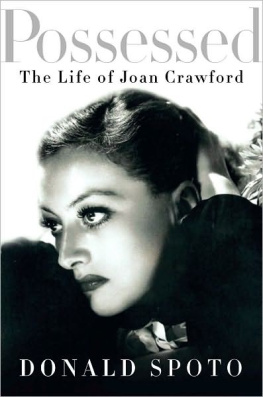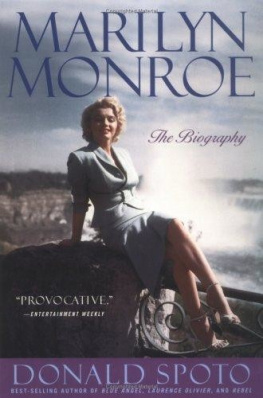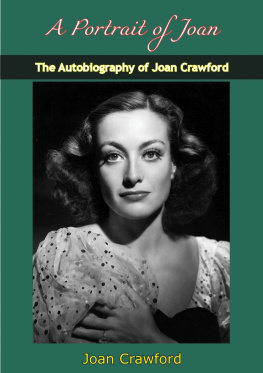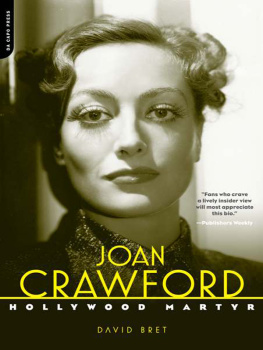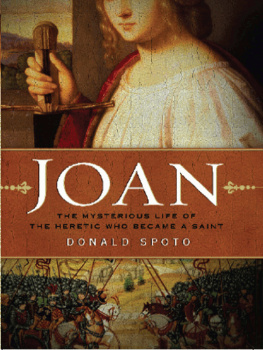JOAN
The Mysterious Life of the Heretic
Who Became a Saint
DONALD SPOTO

for Sue Jett
with love and devotion
Joan: I heard voices telling me what to do. They come from God.
Robert: They come from your imagination.
Joan: Of course. That is how the messages of God come to us.
George Bernard Shaw,
Saint Joan (1923)
Contents
I n libraries and on Web sites, you can readily count hundreds of biographies of Joan of Arc published in English since the middle of the nineteenth century. You will find books for the general reader of biography and for the political and social historian; volumes for the religious and military specialist; treatments for children and for adolescents; tracts for those who have preconceived notions about what this teenage girl was or might have been or failed to be or ought to have been; tomes for those who admire and revere her; and works written for those convinced that she was a cunning charlatan, a deluded patriot, a sexually confused peasant limited by a culture of fear and superstition, or a pitiable psychotic.
This vast and diverse collection does not include a thousand books in French and other languages; nor does it take into account novels, poems, songs, hymns, essays, operas, plays, and films with her as the subject. Paintings and statues depicting Joan appear all over the world, and hundreds of churches have been named for her. She is so familiar as to have become, for many people, almost a clich.
So far as the facts of her life are concerned, it is astonishing to learn that we have more detailed evidence about her than anyone else in the history of the world up to her time. We know far more about Joan, for example, than we do about Moses, Plato, Jesus of Nazareth, Alexander the Great, Julius Caesar, Buddha or Muhammad. For the last two and a half years of her life, we can construct almost a day-by-day account of her whereabouts and actions. We also have several letters she dictated, three of them bearing her simple signature; there is scarcely a single contemporaneous French memoir or chronicle that does not mention Joan the Maid.
Since her death at the age of nineteen in 1431, Joan has fascinated people in many lands. An illiterate girl of remarkable and courageous ingenuity, she boldly confronted a weak and ineffectual heir to the French throne, led rude men in ferocious battles, and was abandoned by the king whose coronation she secured. For all that, her brief presence during the Hundred Years War turned the tide against rapacious English imperialism and enabled France to survive.
Then, in one of historys most egregious miscarriages of justice, Joan was subjected to a bogus trial on an absurd charge of religious heresy. A rigged jury of churchmen turned her over to the English, and she was burned to death as a heretic. Yet her story does not end there. Joan is unique in that she is the only person to be condemned by a Church court for crimes against religion and faith and then later declared a saint of that same Church, worthy of universal reverence.
I T IS TIME for a new book and a fresh take on this extraordinary young woman. Consider, first of all, the curious nature of the historical record. Recent discoveries are begging for a new look at some key original French and Latin documents in light of modern linguistic studies. I have been researching Joans life and its sources for over thirty years, collecting documents and trying to keep up with the scholarly work of others, and during this period I have had to revise many of my earlier conclusions.
In the book you are holding, however, I did not wish either to engage in scholarly debate or to invite academic hairsplitting over matters of narrow historical or military interest. Instead, I was gripped by the power and relevance of Joans life and by her sheer, undiluted faith in the God she believed was guiding her. These are some of the issues that are significant for modern readers.
During Joans trial hundreds of questions were put to her by the Church court. The interrogations of ecclesiastical judges and theological inquisitors, along with her replies, were recorded each day in French by the chief notary, Guillaume Manchon, and by his two assistants, Guillaume Colles (also called Boisguillaume) and Nicholas Taquel. Every evening the three men compared, collated, and corrected their notes. The original of this document is lost to us, but notarized copies have been preserved at the Bibliothque Nationale in Paris and the Bibliothque Municipale in Orlans.
The final and official register of the trial, prepared at the order of the chief judge, Bishop Pierre Cauchon, was based on Manchons minutes but included much more: in fact, Cauchon ordered the record deliberately falsified at crucial points in order to secure Joans condemnation and execution. This trial document was completed in Latin by Thomas Courcelles, who was himself one of Joans judges. He added all the letters from so-called experts as well as Cauchons instructions and those of Jean Le Matre, the deputy inquisitor for France. Also included were the statements of the faculty of the University of Paris and the opinions of other dignitaries. Five copies of this Latin version were made, and three are extant, all of them signed, notarized, and sealed by Cauchon and Le Matre. They are preserved in Paris at the Bibliothque de lAssemble Nationale and the Bibliothque Nationale.
The Courcelles manuscript and an enormous cache of authenticated and relevant documents were compiled, edited, and published in five volumes between 1841 and 1849 by French scholar Jules Quicherat, who included documents relative to the second (posthumous) procedure a quarter century after Joans deaththe trial that reversed the condemnation. Unfortunately, Quicherat harmonized several versions of both long trials and often provided interpretations rather than precise renderings of fifteenth-century French; he also mistranslated many passages. In 1920 and 1921 Pierre Champion compounded the problems when he brought forth a compact and revised two-volume French version of Quicherats work. There have been two English versions of the trial based on Courcelles/Quicherat: an abridged text, rendered often roughly, by T. Douglas Murray in 1902, and another by W. P. Barrett in 1931.
In light of more recent scholarship, Quicherats edition was edited and newly translated into French from 1960 to 1971 by Pierre Tisset and Yvonne Lanhers, whose scholarship included reference to a crucial document at the Bibliothque Municipale dOrlans. Its author and precise date are unknown, but its final form probably comes to us from about 1500, and it provides Joans actual words at the trial. This manuscript (known simply as the Orlans text) essentially replaces the trial as replicated by Quicherat and is indispensable for modern study; I cite it here with my own translations. W. S. Scotts abridged and reconstructed version (1956) was the first in English to use the Orlans manuscript, and to it almost all of my predecessors have turned. But the edition of Tisset and Lanhers deserved far more careful study.
A T THIS POINT serious problems emerge that I tried to remedy in this book. Little recently published material on Joan has taken into account the magisterial work of Pierre Duparc, who from 1977 to 1989 published in five volumes the original Latin and French testimonies and all documentation relevant to the nullification trial of 14551456, casting a bright light on the life of Joan before her brief military career and her early death. Only very short passages based on Duparcs scholarship have so far appeared in English, and those selections are poorly edited and badly translated. I redress this imbalance at least in part by presenting my own translations of representative sections of these documents. These greatly expand our understanding of Joans life, mission, purpose and convictions. I was guided, of course, by the work of scholars who preceded me, not only in studying the trials but also in considering the accounts of Joan written during and immediately after her lifetime. I am grateful most of all to the International Joan of Arc Society, a group whose resources are noted at the beginning of my bibliography.
Next page
